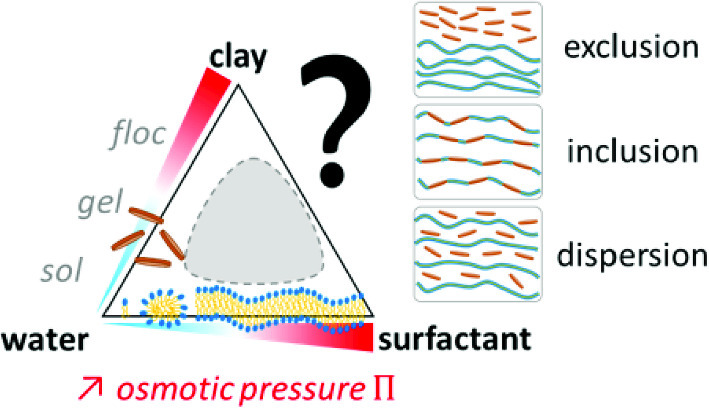https://doi.org/10.1140/epje/s10189-024-00447-2
Regular Article - Soft Matter
Insertion of anionic synthetic clay in lamellar surfactant phases
1
Large Scale Structures, Institut Laue-Langevin – The European Neutron Source, 71, avenue des Martyrs, 38042, Grenoble, France
2
Institut de Chimie Séparative de Marcoule, BP 17171, 30207, Bagnols-sur-Cèze, France
Received:
22
August
2023
Accepted:
23
July
2024
Published online:
12
September
2024
We describe the different mixed colloidal solutions that can be obtained when mixing equivalent quantities of a synthetic anionic clay to surfactants forming lamellar phases in the absence of added salt. The important quantity driving toward insertion or depletion is the osmotic pressure, of the lamellar phase and of the clay alone. Competition for water is the main driving force toward dispersion, inclusion or exclusion (phase separation). In the case of a nonionic surfactant ( ) mixed with Laponite, undulations quenched by the surfactant-decorated clay lead to swelling; inclusion is not observed due to differences in rigidity. Long-range order is weakened leading eventually to the exclusion of surfactant in excess. In the case of a double anionic system (AOT-Laponite), electrostatic is dominant and the three regimes are encountered. In the catanionic case, admixing the double chain cationic lipid DDAB to the clay (in large charge excess), the platelets are coated by a positively charged bilayer. Long-range order is very efficiently dampened. From a low threshold (2% by weight), there is exclusion of a clay-poor collapsed lamellar phase, detected by the swelling of the main phase. The cationized clay does not interfere with the molecular force balance: the location of the critical point is unchanged. At high Laponite concentration, a very puzzling microstructure is observed. Some phase diagrams as well as representative SANS and SAXS data are extracted from the complete results concerning the lyotropic lamellar phase mixing problem available with all measures and evaluations of osmotic pressures in the PhD of the late Isabelle Grillo.
) mixed with Laponite, undulations quenched by the surfactant-decorated clay lead to swelling; inclusion is not observed due to differences in rigidity. Long-range order is weakened leading eventually to the exclusion of surfactant in excess. In the case of a double anionic system (AOT-Laponite), electrostatic is dominant and the three regimes are encountered. In the catanionic case, admixing the double chain cationic lipid DDAB to the clay (in large charge excess), the platelets are coated by a positively charged bilayer. Long-range order is very efficiently dampened. From a low threshold (2% by weight), there is exclusion of a clay-poor collapsed lamellar phase, detected by the swelling of the main phase. The cationized clay does not interfere with the molecular force balance: the location of the critical point is unchanged. At high Laponite concentration, a very puzzling microstructure is observed. Some phase diagrams as well as representative SANS and SAXS data are extracted from the complete results concerning the lyotropic lamellar phase mixing problem available with all measures and evaluations of osmotic pressures in the PhD of the late Isabelle Grillo.
In memory of Isabelle Grillo (1972–2019).
Copyright comment Springer Nature or its licensor (e.g. a society or other partner) holds exclusive rights to this article under a publishing agreement with the author(s) or other rightsholder(s); author self-archiving of the accepted manuscript version of this article is solely governed by the terms of such publishing agreement and applicable law.
© The Author(s), under exclusive licence to EDP Sciences, SIF and Springer-Verlag GmbH Germany, part of Springer Nature 2024. Springer Nature or its licensor (e.g. a society or other partner) holds exclusive rights to this article under a publishing agreement with the author(s) or other rightsholder(s); author self-archiving of the accepted manuscript version of this article is solely governed by the terms of such publishing agreement and applicable law.





